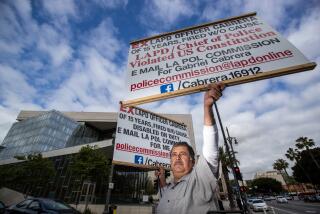Illness Cluster Among Officers Spurs Marrow Drives
- Share via
It was bad enough when Judi Harmon got leukemia. Then Guy Reneau got sick with it, too. A few months later, David Richards was diagnosed with Hodgkin’s disease.
It all happened within a three-year period to these Anaheim police officers, members of a tight and collegial group who regard each other as family. It made everyone wonder if something more than just an unfortunate coincidence was involved.
“It was very odd to think about how two people who work in the same department both get diagnosed, and then Dave,” said Reneau, 42, a homicide detective who was diagnosed with leukemia last July. Last year, two children of other police officers also were diagnosed with cancer.
“People are all scratching their heads,” Reneau said of the cluster of cases.
Anaheim police officers are doing the only thing they figure might help, beyond taking their colleagues dinners and sending cards: They are trying to find bone marrow donors.
Officer Raul Quezada’s 5-year-old daughter Kirstie was diagnosed in December 1998 with acute lymphocytic leukemia, the same type as Harmon’s. And Kerry Condon’s 3-year-old son Kiley was diagnosed about a year ago with neuroblastoma, a cancer of the nervous system.
Aided by the Los Angeles Police Department and police agencies in Orange County and Hawaii, where another officer suffers from leukemia, Anaheim police officers are arranging at least 10 bone marrow drives in May and June. On May 23, the Orange Police Department is sponsoring a drive to help Lt. John Whiteley. On June 2, the Mall of Orange will host a drive.
Doctors say bone marrow transplants are the best chance for these people to survive, because healthy marrow cells can help strengthen faulty immune systems. But finding a compatible donor is difficult. Of the more than 3 million people registered in the National Marrow Donor Program, none are a match for the officers or the children.
Which is why they’ve turned to donor drives.
“Our business is protecting lives,” Anaheim Police Chief Roger Baker said. “If we can get momentum going, [we can] get people to realize . . . that there are thousands [of people] looking for bone marrow matches.”
The illnesses have raised suspicions of a link with the job. But Hoda Anton-Culver, chief of epidemiology at UC Irvine’s College of Medicine and director of its cancer surveillance program, said there is a “good likelihood” that the Anaheim officers’ cases are coincidental.
“Those are very, very small numbers,” she said.
City officials say they investigated to see if the officers’ work might have caused the cancers, but they found nothing.
It was last summer when Reneau first got the sniffles, a fever, headaches and couldn’t breathe right. He thought it was just the flu. He expected a simple explanation from doctors, and maybe medicine.
Instead, doctors told him that chronic myelogenous leukemia had made his white cells divide uncontrollably. His blood was “out of whack,” he said, with white blood cells overrunning his system and making him sick.
“It’s like getting run over by a freight train, or hit with a hammer,” Reneau said. “You’re stunned.”
For information on how to help, contact the American Red Cross at (213) 739-5595.
More to Read
Sign up for Essential California
The most important California stories and recommendations in your inbox every morning.
You may occasionally receive promotional content from the Los Angeles Times.













